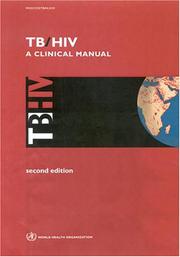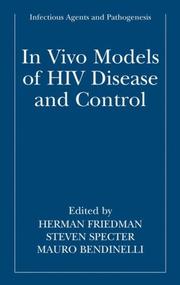| Listing 1 - 10 of 47 | << page >> |
Sort by
|
Book
Year: 1999 Publisher: Philadelphia, Pa Saunders
Abstract | Keywords | Export | Availability | Bookmark
 Loading...
Loading...Choose an application
- Reference Manager
- EndNote
- RefWorks (Direct export to RefWorks)
Nursing --- Infectious diseases. Communicable diseases --- AIDS virus --- AIDS (acquired immune deficiency syndrome) --- verpleegkunde --- aidsvoorlichting

ISBN: 0141187123 9780141187129 Year: 2002 Publisher: London Penguin Books
Abstract | Keywords | Export | Availability | Bookmark
 Loading...
Loading...Choose an application
- Reference Manager
- EndNote
- RefWorks (Direct export to RefWorks)
In 1978 Susan Sontag wrote Illness as Metaphor, a classic work described by Newsweek as "one of the most liberating books of its time." A cancer patient herself when she was writing the book, Sontag shows how the metaphors and myths surrounding certain illnesses, especially cancer, add greatly to the suffering of patients and often inhibit them from seeking proper treatment. By demystifying the fantasies surrounding cancer, Sontag shows cancer for what it is--just a disease. Cancer, she argues, is not a curse, not a punishment, certainly not an embarrassment and, it is highly curable, if good treatment is followed. Almost a decade later, with the outbreak of a new, stigmatized disease replete with mystifications and punitive metaphors, Sontag wrote a sequel to Illness as Metaphor, extending the argument of the earlier book to the AIDS pandemic. These two essays now published together, Illness as Metaphor and AIDS and Its Metaphors, have been translated into many languages and continue to have an enormous influence on the thinking of medical professionals and, above all, on the lives of many thousands of patients and caregivers.
44.01 history of medicine. --- 44.02 philosophy and ethics of medicine. --- 44.78 immunological diseases. --- AIDS (Disease) --- AIDS. --- Cancer --- Social aspects. --- Philosophy and psychology of culture --- Pathology --- Thematology --- Sociology of health --- AIDS virus --- pathologie --- kwaadaardige gezwellen

ISBN: 1281928550 1282168614 9786612168611 9786611928551 0080921299 0123742358 9780123742353 9781317717706 1317717708 1315785501 9781315785509 9780789034106 0789034107 9780789034090 0789034093 9781317717690 9781317717713 Year: 2009 Publisher: Amsterdam ; Boston ; London : Academic,
Abstract | Keywords | Export | Availability | Bookmark
 Loading...
Loading...Choose an application
- Reference Manager
- EndNote
- RefWorks (Direct export to RefWorks)
HIV/AIDS continues to be the pandemic of our times and there has not been a comprehensive medically based AIDS prevention book published in the last 5 years. It is estimated that 36 to 45 million people including 2-3 million children already are infected worldwide and an additional 4-7 million more are infected each year. There are about 6,000 new infections daily and about 12 million AIDS orphans. People receiving AIDS treatments feel well and have no detectable viral load, but still can infect others. And even when a vaccine is found, it will take many years before it can be administered a
HIV infections --- HIV (Viruses) --- Prevention. --- AIDS-associated retrovirus --- AIDS virus --- ARV (Viruses) --- HTLV-III (Viruses) --- HTLV-III-LAV (Viruses) --- Human immunodeficiency viruses --- Human T-cell leukemia virus III --- Human T-cell lymphotropic virus III --- Human T-lymphotropic virus III --- IDAV (Viruses) --- Immunodeficiency-associated virus --- LAV (Viruses) --- LAV-HTLV-III (Viruses) --- Lymphadenopathy-associated virus --- T-lymphotrophic virus III, Human --- HTLV (Viruses) --- Virus-induced immunosuppression

ISBN: 9241546344 9786610436200 9240684441 1280436204 9240681388 Year: 2004 Publisher: Geneva : World Health Organization,
Abstract | Keywords | Export | Availability | Bookmark
 Loading...
Loading...Choose an application
- Reference Manager
- EndNote
- RefWorks (Direct export to RefWorks)
Developments since 1996, particularly in the TB/HIV field, have now prompted a second edition of this popular manual which provides a pocket-sized guide to the clinical management of TB, particularly in patients suffering from co-infection with HIV. Designed for use by busy clinicians, the manual aims to promote the best possible diagnosis and treatment in low-income countries where the prevalence of TB and HIV infection is high, case loads are heavy, and laboratory support may be limited. With these needs in mind, the manual combines the latest scientific knowledge about TB and HIV with autho
Tuberculosis --- HIV infections --- AIDS (Disease) --- Lungs --- Diseases --- Antititubercular agents --- HIV (Viruses) --- Consumption (Disease) --- Phthisis --- Pulmonary tuberculosis --- TB (Disease) --- Chest --- Mycobacterial diseases --- Mycobacterium tuberculosis --- AIDS-associated retrovirus --- AIDS virus --- ARV (Viruses) --- HTLV-III (Viruses) --- HTLV-III-LAV (Viruses) --- Human immunodeficiency viruses --- Human T-cell leukemia virus III --- Human T-cell lymphotropic virus III --- Human T-lymphotropic virus III --- IDAV (Viruses) --- Immunodeficiency-associated virus --- LAV (Viruses) --- LAV-HTLV-III (Viruses) --- Lymphadenopathy-associated virus --- T-lymphotrophic virus III, Human --- HTLV (Viruses) --- Virus-induced immunosuppression
Book
ISBN: 9786612006029 1282006029 1849643741 1435690842 9781849643740 0745327338 9780745327334 9780745327334 0745327338 9780745327327 074532732X 9781770095823 9781282006027 1770095829 6612006021 9781435690844 074532732X 9780745327327 Year: 2008 Publisher: London Ann Arbor, MI Auckland Park, South Africa Pluto Press Jacana
Abstract | Keywords | Export | Availability | Bookmark
 Loading...
Loading...Choose an application
- Reference Manager
- EndNote
- RefWorks (Direct export to RefWorks)
AIDS (Disease) --- HIV (Viruses) --- AIDS-associated retrovirus --- AIDS virus --- ARV (Viruses) --- HTLV-III (Viruses) --- HTLV-III-LAV (Viruses) --- Human immunodeficiency viruses --- Human T-cell leukemia virus III --- Human T-cell lymphotropic virus III --- Human T-lymphotropic virus III --- IDAV (Viruses) --- Immunodeficiency-associated virus --- LAV (Viruses) --- LAV-HTLV-III (Viruses) --- Lymphadenopathy-associated virus --- T-lymphotrophic virus III, Human --- HTLV (Viruses) --- Virus-induced immunosuppression --- Acquired immune deficiency syndrome --- Acquired immunodeficiency syndrome --- Acquired immunological deficiency syndrome --- HIV infections --- Immunological deficiency syndromes --- Political aspects. --- Education. --- Prevention.
Book
ISBN: 9221210634 9789221210634 Year: 2008 Publisher: Geneva : International Labour Office,
Abstract | Keywords | Export | Availability | Bookmark
 Loading...
Loading...Choose an application
- Reference Manager
- EndNote
- RefWorks (Direct export to RefWorks)
This second report documents the fine work carried out by ministries of labour, employers' and workers' organizations and partner enterprises. It gives an insight into this ILO/USDOL partnership which has been running for five years. It includes a special focus on the experiences and achievements of the pioneer country projects in Belize, Benin, Cambodia, Ghana, Guyana, India and Togo. It also captures major innovations and collaborations from on-going initiatives in other countries.
HIV (Viruses) --- AIDS (Disease) --- Health education. --- Health --- Hygiene --- Communication in medicine --- Education --- Health promotion --- Preventive health services --- AIDS-associated retrovirus --- AIDS virus --- ARV (Viruses) --- HTLV-III (Viruses) --- HTLV-III-LAV (Viruses) --- Human immunodeficiency viruses --- Human T-cell leukemia virus III --- Human T-cell lymphotropic virus III --- Human T-lymphotropic virus III --- IDAV (Viruses) --- Immunodeficiency-associated virus --- LAV (Viruses) --- LAV-HTLV-III (Viruses) --- Lymphadenopathy-associated virus --- T-lymphotrophic virus III, Human --- HTLV (Viruses) --- Virus-induced immunosuppression --- Prevention. --- Study and teaching

ISBN: 1280851902 9786610851904 0387257411 0387257403 148997332X Year: 2006 Publisher: New York ; [Great Britain] : Springer,
Abstract | Keywords | Export | Availability | Bookmark
 Loading...
Loading...Choose an application
- Reference Manager
- EndNote
- RefWorks (Direct export to RefWorks)
An AIDS vaccine is still elusive and HIV treatment continues to develop multidrug resistance at alarming rates. Because of the similarities between HIV and immune deficiency infections in a variety of animals, it is only natural that scientists use these animals as models to study pathogenesis, treatment, vaccine development and many other aspects of HIV. Part of the series Infectious Agents and Pathogenesis, this volume reviews the immune deficiency virus in a variety of hosts. Pathogenesis, vaccine and drug development, epidemiology, and the natural history of the monkey, mouse, cat, cow, horse, and other animal viruses are detailed and compared to HIV. Also included are chapters on the history and future of animal models, as well as a chapter on ethical and safety considerations in using animal models for AIDS studies.
HIV infections --- HIV (Viruses) --- Animal models. --- AIDS-associated retrovirus --- AIDS virus --- ARV (Viruses) --- HTLV-III (Viruses) --- HTLV-III-LAV (Viruses) --- Human immunodeficiency viruses --- Human T-cell leukemia virus III --- Human T-cell lymphotropic virus III --- Human T-lymphotropic virus III --- IDAV (Viruses) --- Immunodeficiency-associated virus --- LAV (Viruses) --- LAV-HTLV-III (Viruses) --- Lymphadenopathy-associated virus --- T-lymphotrophic virus III, Human --- HTLV (Viruses) --- Virus-induced immunosuppression --- Emerging infectious diseases. --- Allergy. --- Microbiology. --- Immunology. --- Infectious Diseases. --- Allergology. --- Emerging infections --- New infectious diseases --- Re-emerging infectious diseases --- Reemerging infectious diseases --- Communicable diseases --- Immunobiology --- Life sciences --- Serology --- Microbial biology --- Biology --- Microorganisms --- Allergic diseases --- Allergies --- Hypersensitivity --- Hypersensitivity, Immediate --- Immediate allergy --- Immediate hypersensitivity --- Immunologic diseases --- Immunoglobulin E --- Infectious diseases.
Book
ISBN: 1489995633 146147728X 1461477298 Year: 2013 Publisher: New York : Springer,
Abstract | Keywords | Export | Availability | Bookmark
 Loading...
Loading...Choose an application
- Reference Manager
- EndNote
- RefWorks (Direct export to RefWorks)
Over the past decade, enormous progress has been made in understanding the late events in the HIV replication cycle. This has been made possible by major advances in cell biology, virology, and structural biology. The field continues to move forward rapidly, with important new discoveries being reported on a regular basis. The impact of this progress across a broad spectrum of biomedical research has been substantial. The increase in basic knowledge in the areas of HIV assembly, release, and maturation has been accompanied by new possibilities for therapeutic intervention.The work includes topics relating to basic molecular biology, cell biology, and structural biology of HIV assembly, coupled with more applied ideas of how this basic information can inform the field of antiretroviral research. The book covers all major topics pertaining to the late stages of HIV replication, with leaders in each area recruited to contribute chapters in their areas of expertise . The topics will be sufficiently focused to allow authors the opportunity to cover the latest developments in detail.
Biology --- Health & Biological Sciences --- Microbiology & Immunology --- HIV (Viruses) --- Medical virology. --- AIDS-associated retrovirus --- AIDS virus --- ARV (Viruses) --- HTLV-III (Viruses) --- HTLV-III-LAV (Viruses) --- Human immunodeficiency viruses --- Human T-cell leukemia virus III --- Human T-cell lymphotropic virus III --- Human T-lymphotropic virus III --- IDAV (Viruses) --- Immunodeficiency-associated virus --- LAV (Viruses) --- LAV-HTLV-III (Viruses) --- Lymphadenopathy-associated virus --- T-lymphotrophic virus III, Human --- Medicine. --- Immunology. --- Medical microbiology. --- Virology. --- Biomedicine. --- Medical Microbiology. --- Medicine/Public Health, general. --- HTLV (Viruses) --- Virus-induced immunosuppression --- Medical microbiology --- Virology --- Virus diseases --- Microbiology. --- Clinical sciences --- Medical profession --- Human biology --- Life sciences --- Medical sciences --- Pathology --- Physicians --- Microbial biology --- Microorganisms --- Immunobiology --- Serology --- Health Workforce --- Microbiology

ISBN: 1564323269 Year: 2004 Publisher: New York (N.Y.): Human rights watch
Abstract | Keywords | Export | Availability | Bookmark
 Loading...
Loading...Choose an application
- Reference Manager
- EndNote
- RefWorks (Direct export to RefWorks)
AIDS (Disease) in children --- AIDS (Disease) --- Children's rights --- HIV (Viruses) --- Human rights --- AIDS-associated retrovirus --- AIDS virus --- ARV (Viruses) --- HTLV-III (Viruses) --- HTLV-III-LAV (Viruses) --- Human immunodeficiency viruses --- Human T-cell leukemia virus III --- Human T-cell lymphotropic virus III --- Human T-lymphotropic virus III --- IDAV (Viruses) --- Immunodeficiency-associated virus --- LAV (Viruses) --- LAV-HTLV-III (Viruses) --- Lymphadenopathy-associated virus --- T-lymphotrophic virus III, Human --- HTLV (Viruses) --- Virus-induced immunosuppression --- Acquired immune deficiency syndrome --- Acquired immunodeficiency syndrome --- Acquired immunological deficiency syndrome --- HIV infections --- Immunological deficiency syndromes --- Pediatric AIDS --- Immunologic diseases in children --- Virus diseases in children
Book
ISBN: 1283941554 0821397613 0821397419 Year: 2013 Publisher: Washington DC : World Bank,
Abstract | Keywords | Export | Availability | Bookmark
 Loading...
Loading...Choose an application
- Reference Manager
- EndNote
- RefWorks (Direct export to RefWorks)
Reliable evidence on the results of investments at the community level is in short supply. While communities have played a large role in the HIV/AIDS response, their contributions and innovative approaches to HIV prevention, treatment, care and support have not always been the focus of systematic and rigorous evaluations. To address this gap, seventeen analytical pieces were undertaken including evaluations in Burkina Faso, India, Kenya, Lesotho, Nigeria, Senegal, South Africa and Zimbabwe over a three -year period (early 2009 to early 2012) to build a robust pool of evidence on the effects of
AIDS (Disease) --- HIV (Viruses) --- Outcome assessment (Medical care) --- Prevention. --- Assessment of outcome (Medical care) --- Outcome evaluation (Medical care) --- Outcome measures (Medical care) --- Outcomes assessment (Medical care) --- Outcomes measurement (Medical care) --- Outcomes research (Medical care) --- Patient outcome assessment --- AIDS-associated retrovirus --- AIDS virus --- ARV (Viruses) --- HTLV-III (Viruses) --- HTLV-III-LAV (Viruses) --- Human immunodeficiency viruses --- Human T-cell leukemia virus III --- Human T-cell lymphotropic virus III --- Human T-lymphotropic virus III --- IDAV (Viruses) --- Immunodeficiency-associated virus --- LAV (Viruses) --- LAV-HTLV-III (Viruses) --- Lymphadenopathy-associated virus --- T-lymphotrophic virus III, Human --- Medical care --- HTLV (Viruses) --- Virus-induced immunosuppression --- Evaluation
| Listing 1 - 10 of 47 | << page >> |
Sort by
|

 Search
Search Feedback
Feedback About UniCat
About UniCat  Help
Help News
News